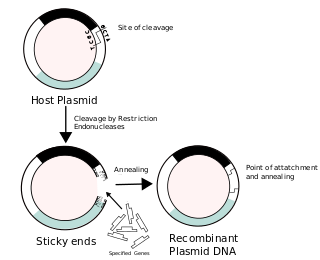
James Dewey Watson is an American molecular biologist, geneticist, and zoologist. In 1953, he co-authored with Francis Crick the academic paper proposing the double helix structure of the DNA molecule. Watson, Crick and Maurice Wilkins were awarded the 1962 Nobel Prize in Physiology or Medicine "for their discoveries concerning the molecular structure of nucleic acids and its significance for information transfer in living material".
Molecular biology is a branch of biology that seeks to understand the molecular basis of biological activity in and between cells, including biomolecular synthesis, modification, mechanisms, and interactions.

Max Ludwig Henning Delbrück was a German–American biophysicist who participated in launching the molecular biology research program in the late 1930s. He stimulated physical scientists' interest into biology, especially as to basic research to physically explain genes, mysterious at the time. Formed in 1945 and led by Delbrück along with Salvador Luria and Alfred Hershey, the Phage Group made substantial headway unraveling important aspects of genetics. The three shared the 1969 Nobel Prize in Physiology or Medicine "for their discoveries concerning the replication mechanism and the genetic structure of viruses". He was the first physicist to predict what is now called Delbrück scattering.

Salvador Edward Luria was an Italian microbiologist, later a naturalized U.S. citizen. He won the Nobel Prize in Physiology or Medicine in 1969, with Max Delbrück and Alfred Hershey, for their discoveries on the replication mechanism and the genetic structure of viruses. Salvador Luria also showed that bacterial resistance to viruses (phages) is genetically inherited.

Sydney Brenner was a South African biologist. In 2002, he shared the Nobel Prize in Physiology or Medicine with H. Robert Horvitz and Sir John E. Sulston. Brenner made significant contributions to work on the genetic code, and other areas of molecular biology while working in the Medical Research Council (MRC) Laboratory of Molecular Biology in Cambridge, England. He established the roundworm Caenorhabditis elegans as a model organism for the investigation of developmental biology, and founded the Molecular Sciences Institute in Berkeley, California, United States.

Cold Spring Harbor Laboratory (CSHL) is a private, non-profit institution with research programs focusing on cancer, neuroscience, plant biology, genomics, and quantitative biology. It is located in Laurel Hollow on Long Island, New York.

Recombinant DNA (rDNA) molecules are DNA molecules formed by laboratory methods of genetic recombination that bring together genetic material from multiple sources, creating sequences that would not otherwise be found in the genome.
Joseph Frank Sambrook was a British molecular biologist known for his studies of DNA oncoviruses and the molecular biology of normal and cancerous cells.
Tom Maniatis, is an American professor of molecular and cellular biology. He is a professor at Columbia University, and serves as the Scientific Director and CEO of the New York Genome Center.

Bruce Michael Alberts is an American biochemist and the Emeritus Chancellor’s Leadership Chair in Biochemistry and Biophysics for Science and Education at the University of California, San Francisco. He has done important work studying the protein complexes which enable chromosome replication when living cells divide. He is known as an original author of the "canonical, influential, and best-selling scientific textbook" Molecular Biology of the Cell, as an Editor-in-Chief of Science magazine. He was awarded the National Medal of Science for "intellectual leadership and experimental innovation in the field of DNA replication, and for unparalleled dedication to improving science education and promoting science-based public policy" in 2014.

Hugh John Forster Cairns FRS was a British physician and molecular biologist who made significant contributions to molecular genetics, cancer research, and public health.
Allan McCulloch Campbell was an American microbiologist and geneticist and the Barbara Kimball Browning Professor Emeritus in the Department of Biology at Stanford University. His pioneering work on Lambda phage helped to advance molecular biology in the late 20th century. An important collaborator and member of his laboratory at Stanford University was biochemist Alice del Campillo Campbell, his wife.
Garland Science was a publishing group that specialized in developing textbooks in a wide range of life sciences subjects, including cell and molecular biology, immunology, protein chemistry, genetics, and bioinformatics. It was a subsidiary of the Taylor & Francis Group.
The phage group was an informal network of biologists centered on Max Delbrück that contributed heavily to bacterial genetics and the origins of molecular biology in the mid-20th century. The phage group takes its name from bacteriophages, the bacteria-infecting viruses that the group used as experimental model organisms. In addition to Delbrück, important scientists associated with the phage group include: Salvador Luria, Alfred Hershey, Seymour Benzer, Charles Steinberg, Gunther Stent, James D. Watson, Frank Stahl, and Renato Dulbecco.

Stephen J. O'Brien is an American geneticist. He is known for his research contributions in comparative genomics, virology, genetic epidemiology, mammalian systematics and species conservation. Member of the National Academy of Sciences and a Foreign Member of the Russian Academy of Sciences. Author or co-author of over 850 scientific articles and the editor of fourteen volumes.

Keith Burridge is a British researcher and Kenan distinguished Professor at the University of North Carolina at Chapel Hill. His research on focal adhesions includes the discovery of many adhesion proteins including vinculin, talin and paxillin, and ranks him in top 1% of the most cited scientist in the field of molecular biology and genetics. Burridge has published more than 200 peer reviewed articles.
Jeffrey David Esko, Ph.D.,M.D. (h.c) is currently a Distinguished Professor of Cellular and Molecular Medicine and Co-Director of the Glycobiology Research and Training Center at the University of California, San Diego. His research has focuses on understanding the structure, biosynthesis and biological roles of proteoglycans in mammalian cells and model organisms. Esko popularized proteoglycans through his pioneering genetic and functional studies in cells and model organisms. He discovered the dependence of tumor formation on heparan sulfate, the first small molecule inhibitors of heparan sulfate, the action of proteoglycans as receptors for hepatic lipoprotein clearance and for delivery of therapeutic agents. Esko cofounded Zacharon Pharmaceuticals. He was an editor and author of the first textbook in the Glycobiology field, Essentials of Glycobiology.
John Tooze FRS was a British research scientist, research administrator, author, science journalist, former executive director of EMBO/EMBC, director of research services at the Cancer Research UK London Research Institute and a vice president at The Rockefeller University.
Miranda Robertson is a scientific editor. She is known for serving as Biology Editor at Nature from 1983 to 1992, during which time Nature's visibility and influence in the life sciences substantially increased, and for her contributions to the influential textbook Molecular Biology of the Cell. As editor of BMC's open-access Journal of Biology, she introduced pioneering improvements in the process of peer review, including the ability for authors to opt out of re-review.
Terri Grodzicker is an American molecular geneticist and virologist who is currently the Dean of Academic Affairs at Cold Spring Harbor Laboratory. She also serves as the editor-in-chief of Genes & Development. Her research is in the field of human Adenoviridae. During her career at Cold Spring Harbor Laboratory she has edited more than a dozen books, and co-authored papers and books with other renown members of the laboratory such as Joseph Sambrook and Bruce Stillman.










